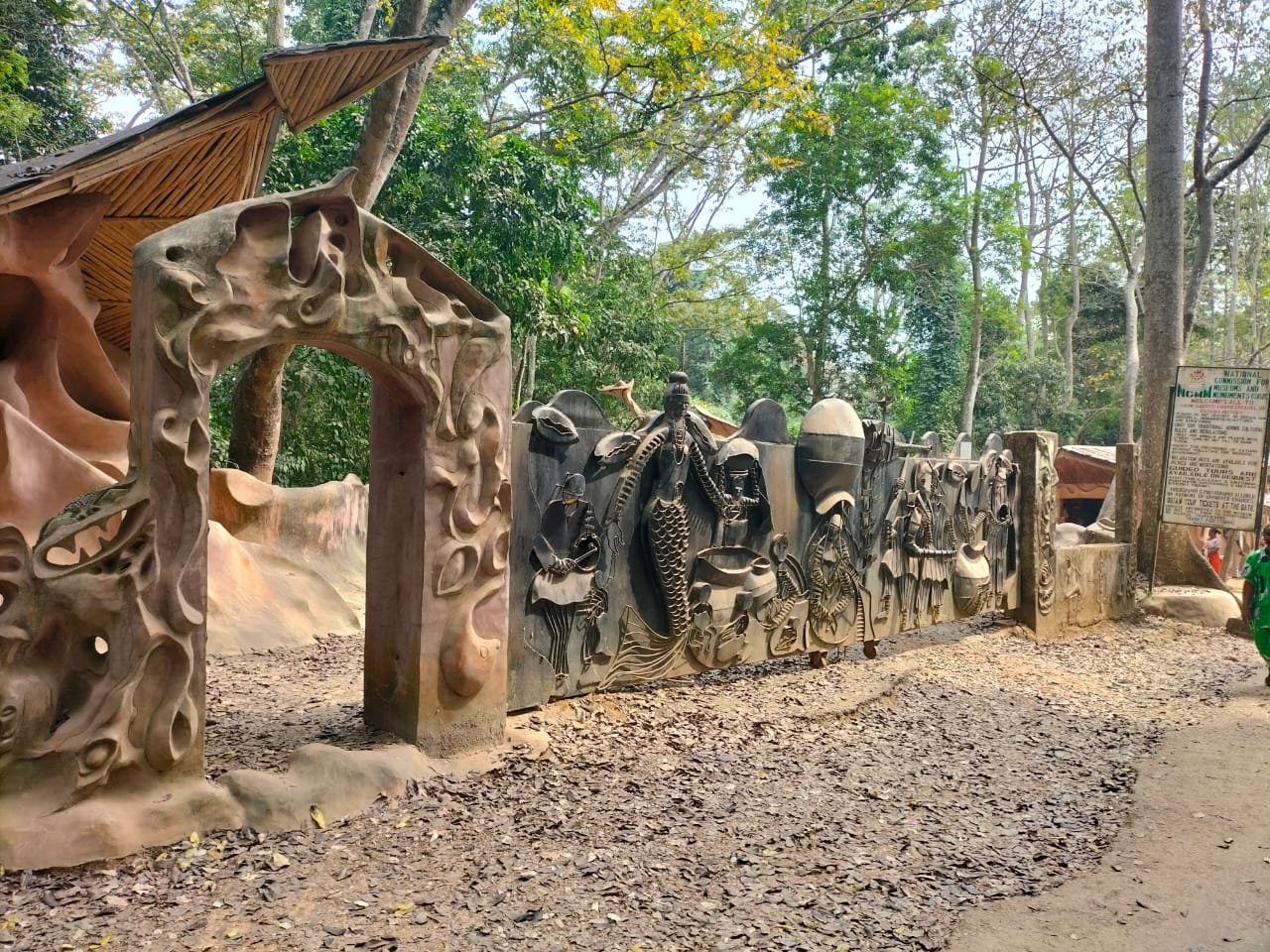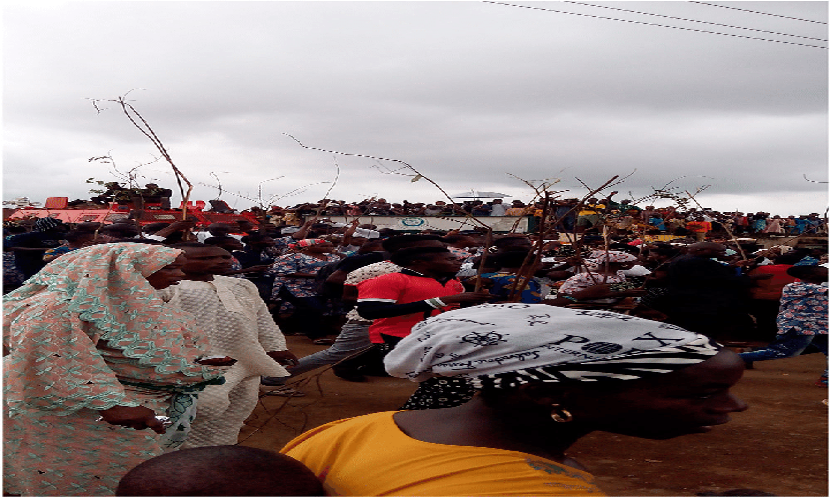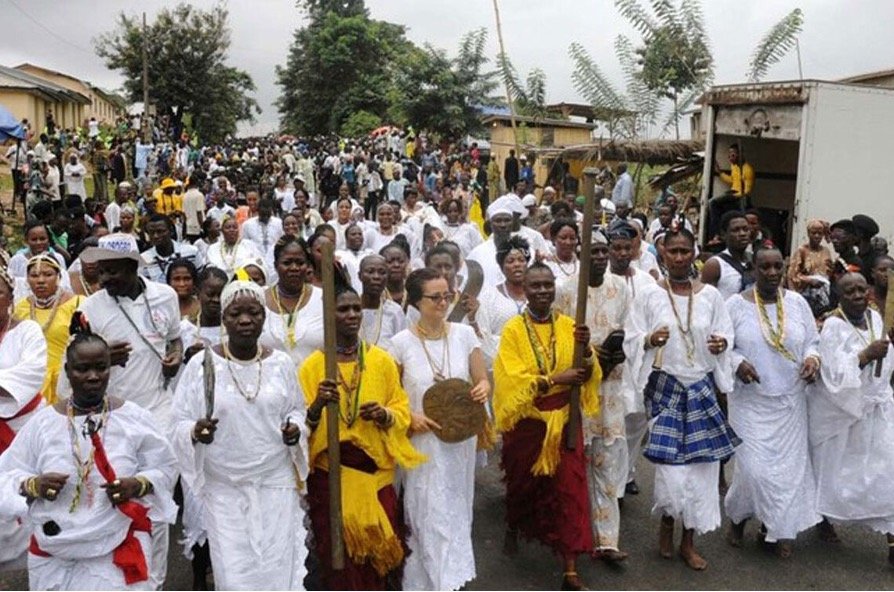The Osun-Osogbo Sacred Grove
By Abdul-lateef Awodele
The Osun Sacred Grove is situated in the dense forest on the outskirts of the city of Osogbo; Osun State capital remains one of the existing major high forests in southern Nigeria. It boasts scores of shrines, sculptures and other various works of art erected to honour the goddess Osun. This ancient temple, founded over 400 years ago, is believed to be her home. Yoruba myth has it that Osun, a goddess of fertility and a beauty queen, was one of the three wives of Sango, the third Alaafin of Oyo Empire and Orisa (god) of thunder. It is believed that Osun, having left the Oyo palace in Oyo-Ile, settled at the grove and transformed into the Osun/Oshun River.
The sacred temple and its winding river topography is surrounded by shrines and other temple collections in the form of sculptures and other art works erected in honor of Osun and other Yoruba deities. Recognized as a symbol of indigenous spirituality amongst the Yoruba race, the sacred grove is undoubtedly one of the most important surviving heritage sites in the Yoruba culture. It comprises two palaces, five sacred sites and nine other worship locations, each possessing its own appointed priests and priestesses (Oyeweso, 2013). As Adedeji and Fadamiro (2018) have noted, groves in Yoruba traditional religion are regarded as sacred places that are reserved for rites and rituals.
Recently, new art works installed under the lead of Yeye (Priestess) Susane Wenger, who worked at the grove from 1960s until her death in 2009, made the sacred grove look completely unique. Osogbo, the home of Osun grove, is distinguished by having a huge array of 20th century sculpture made to strengthen the connections between the Yoruba race and people from all walks of life with the sacred temple, in the same way towns in Yoruba land connect their establishment and development to the spirits of the forest (Oparanti, 2004).
The Shrine of Oshun, the water dwelling fertility goddess of the Yoruba religion in southwestern Nigeria.
Fall and the Rise
Prior to the colonial infiltration of Africa in the 19th century, the grove was the major worship center for Osogbo people. However, by 1950 many of the activities in the shrine had declined as a result of neglect and the priests’ abandonment of the grove due to weakness of customary responsibilities and sanctions. However, the arrival of the Austrian anthropologist Susanne Wenger helped to reinstate traditional protections as well as construction and modernization of temples around the grove.
The amazing work done by artists encouraged by Wenger in restoring the grove has added a new value to the sacred grove making it a sacred center for the entire Yoruba race. This recent development also gives the grove an identity for Yorubas in the Diaspora, especially the descendants of the millions of carted away slaves now domiciled in the Americas.
Today, the Grove comes to life as a worship place on a daily, weekly and monthly basis. In addition, there is a processional festival every year for the re-establishment of the spiritual bonds between the river goddess and the people living in the town. This yearly event is held for twelve days between July and August. This festival helps sustain the existing cultural traditions of the Yorubas.
The Osun-Osogbo festival is thought to have a history dating back more than 700 years, according to Yoruba mythology. This festival was first observed because of an ancient occurrence. A group of migrants, commanded by Olutimehin (a great hunter), settled on the bank of the Osun river to escape starvation, according to Oyeweso's (2013) historical account, Yeye Osun, the river goddess, made an appearance on the riverbank in front of Olutimehin and asked him to guide the crowd to a specific location: the present-day Osogbo town (Awe & Albert, 1995). The goddess demanded an annual sacrifice in exchange for which she would guarantee the group's safety and prosperity: this was accepted by the group. This acceptance of the demand by the group and the continuous prosperity of the town are the major influence for the annual sacrifice to the Osun River Goddess which is celebrated as the Osun-Osogbo Festival (Oyeweso, 2013).
The Goddess (OSUN)
Besides its importance as a core cultural heritage site for the Yoruba people generally, the Osun goddess is almost everything to the people of Osogbo: she is considered the mother, protector, guard, and the nurturer of the town (Badejo, 1995; Oyeweso 2013). Osun – the ‘Great Mother’ (Yeye) as she is referred to in many of the poems about her – possesses magical powers to heal all forms of human diseases, particularly those that affect mothers and children. Her abilities include making supposedly barren women fertile and to heal infertility in men (Badejo, 1995). These majestic powers attributed to the water spirit of Osun makes the Osun Osogbo festival a central point of visitations by numerous believers and worshippers from different places across the world, especially from the African diaspora community.
Osun metal artwork, made during the priesthood of Yeye Susanne Wenger. Photograph taken by the author in August, 2022.
The Therapeutic and Divinatory Nature of the Grove
The Grove is regarded as a natural herbal pharmacy, having more than 400 plant species, some endemic, of which over 200 species are famous for their therapeutic uses. Furthermore, the Osun-Osogbo Grove is a place of substantial expression of divinatory and cosmological belief in the Yoruba world view, with daily, weekly, monthly and yearly spiritual activities taking place in the location. The annual festival held to commemorate the grove is a thriving and growing response to Yoruba beliefs in the connection between the Yorubas, their rulers and the Osun goddess.
The Festival
The festival is held yearly in August to celebrate the goddess of the shrine. Divided into five events, the programme begins with Iwopopo, a traditional cleansing of the city and the cultural reunion of the people with their ancestors, the founders of the Osogbo Kingdom.
Indigenes and chiefs of the town prostrating to the King (Ataoja of Osogbo)at the Iwopopo event in August 2022.
This is followed by the lighting of the 500-year-old sixteen-point lamp called 'Ina Olojumerindinlogun’, a sacred lamp lit on the second day of the annual Osun-Osogbo festival. The lighting ceremony takes place in the courtyard of Ataoja's palace. The Olojumerindinlogun lamp is a metal column that carries sixteen containers that resemble trays and are filled with cotton and palm oil. The sixteen lamps signify the sixteen primary Orisa (gods) who organized the world, the sixteen major Odu Ifa, and the sixteen palm nuts utilized in Ifa divination, according to Yoruba cosmic origin of the sixteen-point lamp (Abimbola, 1977). The lamps are normally lit on a Thursday night at 7pm and kept burning until dawn on Friday. The Ataoja, the Osun priestess, and other Osun worshippers often circle the lit lamp three times (Oyeweso 2013). The day is also expected to have other events such as singing, dancing, drumming, and spiritual invocations where Kabiyesi (King) moves to the town center and the popular Oja Ọba (The King's Market) to pray for the land.
The ina olojumerindinlogun (sixteen lamp) lighting that forms part of the festival.
The Ibo oriade comes third on the list of activities for the Osun Osogbo festival. This involves sacrifice for all the past Ataoja and their Crowns (Ojo Ibori and Iboade), The 'Iboriade', is an assemblage of the crowns of the past rulers (the Ataojas of Osogbo), for blessings over the town. These sacrifices also include those done for the past Ataojas’ wives (Ojo Ayaba Isale) and sacrifice for the House/Palace of the past Ataoja (Ojo Ogboni). According to Oyeweso (2013), this is followed by a special programme during which the Ataoja feasts all his chiefs, family members and the general public and gives alms to the poor in the society.
The Ifa Arugba, which comes a day before the grand finale of events marking the Annual Osun Osogbo Festival, is another sacred ritual followed by a secular ritual drama. The Arugba (Votary Maid), who must be a female virgin, usually leads the procession of Osun devotees to the grove by carrying a symbolic calabash containing the sacrificial items for the sacrifice. This calabash is thereafter offered to Osun goddess. The Arugba is protected on her journey to the grove by the Olose (Whip Boys and festival security) who protect her from being hurt or falling. These Olose ensure that the Augba has a problem-free exercise, as the success of the festival is largely dependent on the hitch-free walk of Arugba.
The Arugba being escorted by priest and priestess during the festival.
The Arugba being followed by whip boys and other well wishers.
Usually the last event that marks the Osun-Osogbo festival is the Osun festival finale which takes place at the shrine in the Osun grove. The event is divided into private and open programmes. First, after the Arugba has taken the calabash to the grove for the annual rituals, the sacred bond and renewal of the pathway between the goddess and the people of Osogbo are conducted in seclusion by the Ataoja and the Osun priests and priestesses inside the sanctuary at the Osun grove. The Ataoja of Osogbo, upon receiving the sacrifice from the Osun priestess and Osun priest, sits on the stone of authority, communes with his ancestors and feeds the goddess with the sacrificial items brought earlier by the Arugba. The feeding of the goddess by the Ataoja marks the end of the rituals of Osun festival and this confirms that the waters of the river are blessed.
After the sacred rituals at the inner shrine of the grove have been completed, the secular ritual drama which encompasses the reenactments of some historical events takes place with the general public witnessing the festival. There are activities such as drumming, dancing, musical performances, wearing of elaborate costumes, speaking of the Yoruba language and recitation of praise poetry. People from different walks of life sing words of praise – ‘Ore Yeye Osun’ (We adore you Osun the Great Mother) – and then locals and travelers start drinking and washing their faces in the river for blessings while some seek cures for various diseases such as barrenness, infertility, chronic headache and other forms of ailments (Joseph, 2001).
The Osun priestesses during the festival.
The Legitimacy of the Site
The legitimacy of the Grove has much to do with its significance as a sacred site. The sacred characteristics of places like this can only be constantly strengthened if that sacredness is generally refereed.
In the last two decades, the newly introduced sculptures have had a great impact in reinforcing the exceptional qualities of the Grove, thereby returning its sacred qualities which fill it with high cultural value. The new sculptures at the same time remain part of a long tradition of sculptures that were made to reveal the cosmology of the Yoruba race.
Despite the fact that their appearances reflect a stylistic change, the art works were not made to exalt the artists; the huge size of the art works rather give them frightening shapes aimed at enhancing the sacredness of the Grove.
The main purpose of the recently installed sculptures has been achieved and the Grove now has gone beyond just local significance to become a sacred place for the Yoruba people; visitors from the African diaspora also are important annual participants of the festival
The Prerequisites for Protecting and Managing the Grove
The first declaration of the grove as a National Monument was made in the year 1965. Then in 1992 there was an amendment to the initial designation and various extension workswere carried out on the grove in order to protect this national monument. According to the Nigerian Cultural Policy of 1988, which is aimed at preserving all national monuments and sites, the Grove’s trusteeship was given to the Osun State Government by the Federal Government of Nigeria according the Land Use Act of 1990 of the Federal Republic of Nigeria. Since then, the Grove has experienced intense management, especially between 2004 and 2009, making the sacred site to enjoy a participatory management system from all the stakeholders involved.
The Osun State Government in conjunction with the Federal Government of Nigeria, through the National Commission for Museums and Monument site manager, contribute to the protection and management of the site through its respective Local Government Areas, Ministries and Agencies, who are also empowered to manage monuments within their jurisdictions. Also, the traditional responsibilities of the hosting community and the cultural rites are carried out through the Osogbo Cultural Heritage Council led by the Ataoja of Osogbo and his council (Tourism Development in Osun State, 2008).
The site has enjoyed protection through the various traditional activities like traditional laws, myths, taboos and customs that have been put in place to forbid people from fishing, poaching, hunting, farming or felling trees in the seventy-five hectares expanse of the undisturbed forest.
The traditional worshippers and devotees of the grove maintain the intangible tradition through spiritualism, reverence and representation. There is a management committee comprising all groups of stakeholders which has been set up to implement policies, measures and activities for the sustainable development of the sacred site.
The Osun-Osogbo Sacred Grove is also part of the National Tourism Development Master Plan that was established in partnership with World Tourism Organization (WTO) and United Nations Development Programme (UNDP). Meanwhile, the Grove with proper management and adequate protection will also serve as a model of African heritage that preserves the intangible heritage of the entire Yoruba people, especially the people from Osogbo, while also remaining a living flourishing heritage with traditional landmarks and an authentic means of transferring traditional religion, and indigenous knowledge systems, to the people of Africa in the Diaspora.
Abdul-Lateef Abiodun Awodele holds a master’s degree in Diaspora and Transnational Studies from the Institute of African Studies, University of Ibadan. He is currently a research fellow at the Institute of French Research in Africa. His research is centered on diaspora and ethno-diaspora communities, ethnic migration, diaspora return, pilgrimage and cultural participation. Outside academia, Abdul-Lateef is a data science enthusiast and a content creator.
References
Abimbola, W. (Ed.). (1977). Ifa Divination Poetry. New York: Nok Publishers.
Adedeji, J. A. & Fadamiro, J. A. (2018). ‘Urbanisation forces on the landscapes and the changing value-systems of Osun Sacred Grove UNESCO Site, Osogbo, Nigeria.’ Landscape Research, 43(6), 798-816.
Awe, B., & Albert, O. (1995). Historical development of Osogbo. Model of Growing African Town. Journal of African Studies, University of Ibadan. p.3.
Badejo, D. L. (1995). Osun Seegesi: The Elegant Deity of Wealth, Power and Femininity. Trenton, N.J: Africa World Press.
Joseph, M. M. and Mei-Mei, S. (2001) “Introduction” in Joseph M. Murphy and Mei-Mei Sanford (eds.), Osun Across the Waters: A Yoruba Goddess in Africa and the Americas. Bloomington, Indiana: Indiana University Press, p.2.
Oparanti, G. O. (2004) “The Origin of Osun Festival”, Osun Osogbo 2004 Official Magazine. Osogbo: Office of the Ataoja of Osogbo and Osun State Government, p.10.
Oyeweso, S. (2013). Osun Osogbo festival: its origin, nature and significance for global Yoruba cultural advancement. IACIU (Journal of African Culture and International Understanding), 2(2), 21-30.
Pemberton, J. & F. Afolayan (eds.), (1996) Yoruba Sacred Kingship: A Power like That of the Gods. Washington, London: Smithsonian Institution Press, p.99.
Tourism Development in Osun State (A Publication of the Osun State Ministry of Tourism & Culture, 2008).






